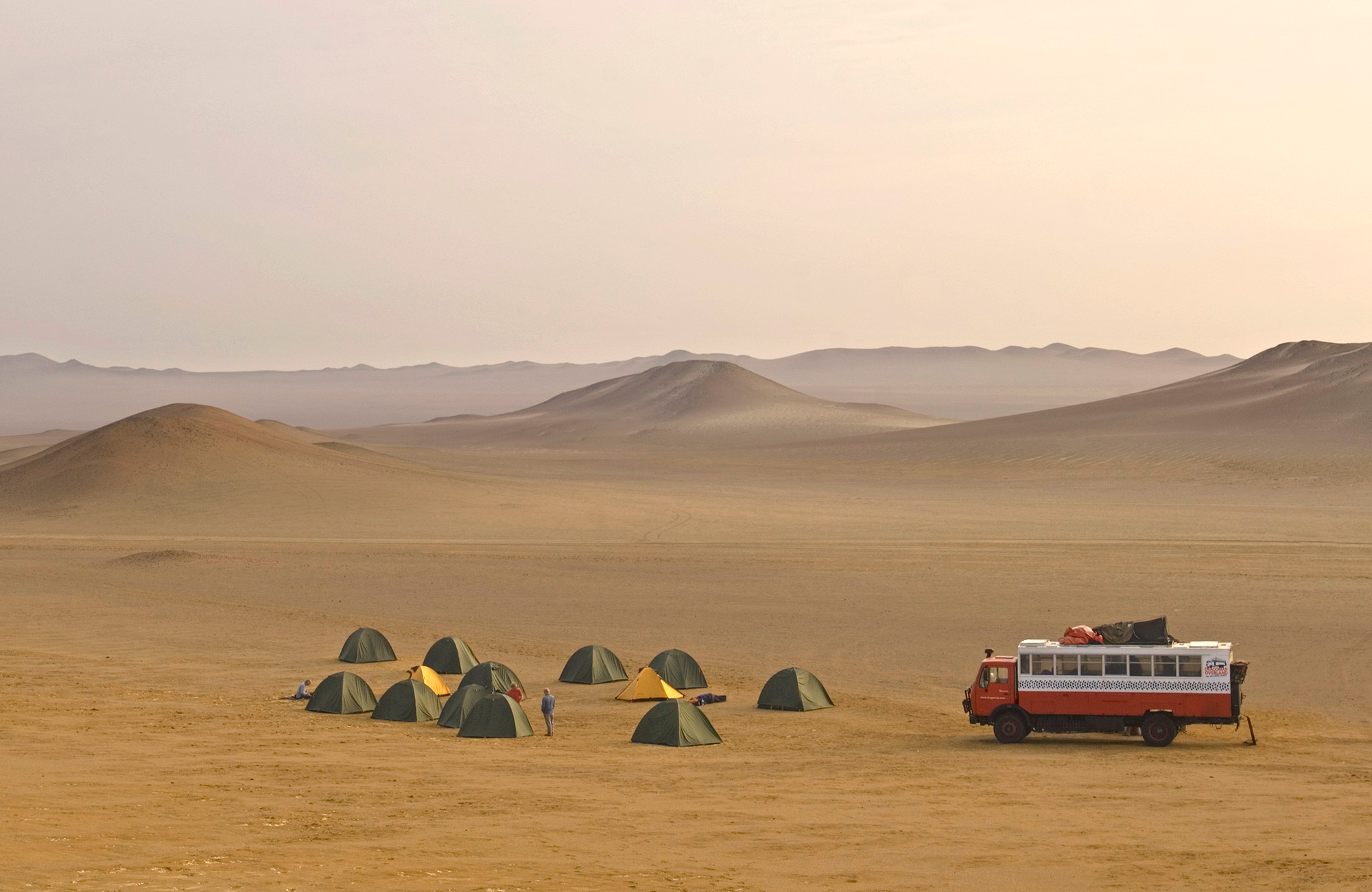Overlandture er for dig der drømmer om en helt ny måde at rejse på. Er du til adventure, action og vil du rejse "off the beaten track"? Så er en overlandrejse sandsynligvis noget for dig. Du kan komme på denne type rundrejse i det meste af verden, og vi hjælper dig naturligvis med planlægningen!
Book et møde og hør om mulighederne!
OBS: Begrænset udvalg i øjeblikket
Mange af vores samarbejdspartnere har som følge af COVID-19 desværre været nødsaget til helt eller delvist at begrænse deres udbud af overlandsrejser. Det betyder naturligvis, at vi ikke kan hjælpe med helt det samme udvalg, som vi tidligere har kunne. Hvis du drømmer om at rejse overland, så tag fat i os, og hør hvad mulighederne er på det tidspunkt, du gerne vil rejse.
På en overlandrejse er du af sted med andre eventyrlystne
Det handler om dig, der kører rundt i en stor ombygget truck med andre eventyrlystne fra hele verden. De fleste rejsende oplever nye lande på egen hånd med en Lonely Planet i håndet og håndterer selv transport med bus, tog og taxier - og måske booker de en guidet tur eller to undevejs. Overlanding, derimod, er noget helt, helt andet når det kommer til at se og opleve uudforskede steder på kloden. På en overlandtur kommer du "off the beaten track", altså derud hvor andre meget sjældent kommer.
Du oplever områder der er så øde, at andre turguider ikke vil tage derhen - ikke pga. fare, men fordi at der er øde, og fordi at det er lidt af en rejse at komme dertil og tilbage igen. Men I har jeres seje guide, der står i spidsen for ekspeditionen, og guiden skal nok sørge for, at I får den fedeste oplevelse.
5 grunde til at en overlandtur er den ultimative rejseform
En overlandtur handler om, (ja du gættede det), at rejse over land. I stedet for at flyve mellem landene vil din rejse foregå sammen med andre eventyrere i en truck, der er bygget til formålet. Her får du 5 grunde til, at en overlandtur er den bedste måde at opleve en destination.
1. Get off the beaten track
Det er lidt en kliché, vi ved det, men det er stadig sandt. På en overlandtur kommer du væk fra den værste masseturisme og ud og oplever de autentiske dele af et land. Du kommer selvfølgelig stadig til at opleve de store højdepunkter, uanset om det er den spektakulære Jinshanling-del af Den Kinesiske Mur, det majestætiske Iguazu Falls mellem Argentina og Brasilien eller toppen af Inkaruinen Machu Picchu. Men det vil altid være i kombination med en episk rejse gennem de afsides dele af landet, hvor du vil få mulighed for at interagere med de lokale. Du kommer til at bo hos Gauchoerne i Argentina, hvor du vil lære at kaste en lasso, du kommer til at møde stammefolk i den sjældent besøgte Odisha-region i Indien og du vil komme til at opleve magiske voodoo-ceremonier i landsbyer i Vestafrika. For mange rejsende er det disse unikke oplevelser, der er de mest mindeværdige dele af rejserne.
2. Sæt farten ned
Er du nogensinde kommet hjem fra en rejse, hvor du nærmest føler dig mere udkørt end inden du tog af sted? En Overlandrejser handler om at nyde rejsen lige så meget som selve destinationen. Når du rejser i en truck, der er bygget til længere rejser, er det en god anledning til at sætte farten ned og opleve mere.
Forestil dig, at du har mulighed for at nyde en guided tur i en Tata Somba-landsby i det nordlige Benin, eller lære at sætte en traditionel Kyrgisisk jurte op af de lokale fårehyrder. Eller hvad med muligheden for at nyde en solnedgang i den utrolige Moon Valley i San Pedro de Atacama i Chile. Der findes ingen bedre måde at lære et land at kende, og det er den perfekte kontrast til vores alt for travle og stressende hverdag.
3. Rejs med ligesindede
Når du rejser på en overlandtur, er dine medpassagerer lige så stor en del af oplevelsen som destinationen i sig selv. Det smukke ved denne rejseform er, at det tiltrækker folk med alverdens forskellige baggrunde. Grupperne består ofte af solo-rejsende, par, vennegrupper og folk med forskellige nationaliteter, baggrunde og syn på verden. Tilfælles har I til gengæld alle de fede oplevelser, der venter jer som en samlet gruppe, og tro os, der opstår hurtigt gode venskaber på kryds og tværs i gruppen.
4. Du bestemmer længden på turen
Der er mange (!) forskellige overlandture, og du kan tage af sted på en rejse der varer alt fra et par dage til flere måneder og endda år. Du kan både vælge at bryde en lang rejse op i flere dele, eller gå efter en tur i ét stræk. Mange af vores overlandture er virkeligheden en sammensætning af flere ture. Det betyder også, at du kan vælge blot at booke den første del af en længere rejse, hvorefter du kan 'genoptage' din rejse, derfra hvor du sluttede, på et senere tidspunkt.
5. Rejs langs nogle af verdens mest ikoniske ruter
Uanset om du gerne vil følge i fodsporene på nogle af de første rejsende handelsfolk langs Silk Road i Asien, eller om du vil af sted langs Amerikas rygrad fra Anchorage i Alaska til Ushuaia i det sydlige Argentina, så kan en overlandrejse give dig en måde at opleve et land på, som traditionelle toge, busser og fly bare ikke kan.


